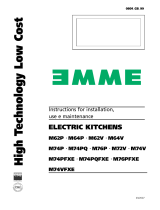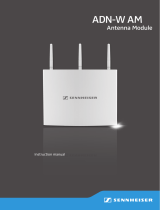6 - INSTRUCTIONS FOR USE
0808_GB_42 - ELECTRIC FRY TOP
8 · 12
04/2008
6.2 Start-up
Before using the appliance for the first time, thorou-
ghly clean the smooth or grooved surface of the plate
with lukewarm water and detergent, using a soft cloth
to eliminate all trace of the rust-proofing applied in
the workshop. Dry with a clean cloth.
Check that the fat tray is in place.
Turn on the main switch upstream of the appliance.
With knob (pos. 1 fig. 1) turn the thermostat from the “0” position
to a desired temperature between 50°C and 300°C; the indicator
light will come on; the green one (pos. 2 fig. 1) shows that the
appliance is on, the yellow one (pos. 3 fig. 1) indicates that the hea-
ting elements are operational, as soon as the set-up temperature is
reached, the indicator light goes off.
To turn the appliance off, turn the knob to position “0”.
Special precautions
It is recommanded to keep cleaning the plate during use,
using a scraper or a dampf cloth to remove particles of food
which could start smoking and causing unpleasant smells.
6.3 Cleaning and taking care of the machine
• Never clean the appliance with jets of water, whether direct or
pressurised!
• Remove, empty and wash the fat tray.
• Never clean the appliance before it has cooled down.
• Rinse the surface with clean water and a soft cloth to get rid of
all traces of detergent.
• When finished using the appliance, it should be cleaned thorou-
ghly every evening.
• Before starting to clean the appliance, disconnect from the
mains. The surfaces and steel parts should be washed in warm
water using a neutral detergent. Avoid using abrasive or corrosi-
ve detergents which could damage the steel.
• Remove any remaining particles of food from the burner surface
by using a scraper or a damp cloth.
• Thoroughly dry the appliance.
• Cleaning the appliance daily guarantees perfect long-term opera-
tion.
6.4 Turning the appliance off in case of
breakdown
6.4.1 What to do in case of failure
In case of breakdown or malfunctioning or failure turn off the appli-
ance. Switch off any electric power. Call the service centre.
6.4.2 What to do in case of prolonged period of disuse
When the appliance is not to be used for a long time, clean thor-
oughly, cas instructed in the chapter 6.5 “Appliance care and fre-
quency of maintenance”, switch off any electric power.
6.5 Appliance care and frequency of maintenance
Attention! When cleaning, carefully avoid washing the
appliance with direct water jets or high-pressure
water!
Cleaning must be performed when the appliance is cold.
Thorough daily cleaning of the appliance, after disconnecting it, will
keep it in perfect working order and make it last longer. All steel
parts should be cleaned with water and a detergent, using a damp
cloth; do not use abrasive substances or corroding detergents.
Do not use steel wool, which could cause rust to form.
For the same reason, avoid touching the appliance with anything
made of iron. Do not clean with sandpaper and lubricating gel paper.
If absolutely necessary, you may use pumice powder.
If the appliance is extremely dirty, use a synthetic sponge (i.e.
Scotchbrite sponge).
After cleaning the appliance, rinse with clean water and wipe with
a clean cloth.
All maintenance and repair work must be carried out by authorized
technicians only.
The appliance must be checked at least once a year. For this reason,
a service agreement contract is recommended.
6.6 Recommendations for the treatment of
stainless “steel industrial” kitchens
6.6.1 Useful information on “stainless steel”
Industrial kitchens are generally made of “stainless steel” having
the following material codes:
• 1.4016 or 1.4511 = magnetizable chromed steels
• 1.4301, 1.4401 and 1.4571 = non-magnetizable chromed steels
Chromed steels have favourable thermo-technical characteristics. In
fact, they have less of a tendency to warp due to the effect of heat.
Chrome-nickel steels, instead, have good corrosion resistance features.
“Stainless steel” corrosion resistance is given by an inactive coat
that builds up on the surface by coming into contact with oxygen.
The oxygen in the air is already enough to build up the inactive
coat that allows automatic removal of anomalies and damage due
to mechanical actions. The inactive coat builds up or re-builds up
faster if the steel comes in contact with running water containing
oxygen.
A more powerful effect is given by oxidative acids (nitric acid, oxalic
acid). These acids are used if the steel has undergone strong chemi-
cal stresses, hence generally losing its inactive coat.
The inactive layer can be chemically damaged or jeopardized by
reducing agents (oxygen consumption) if they come in contact with
the steel, concentrated or at high temperatures. These active sub-
stances include for instance:
• saline and sulphurous substances
• chlorides (salts)
• concentrated spices such as mustard, vinegar essences, soup
cubes, kitchen salt solutions, etc.
More damage can be caused by:
• outside rust (i.e. from other components, tools or incipient rust)
• iron particles (i.e. file dust)
• contact with non-ferrous metals (element build up)
• lack of oxygen (i.e. no air inlet, water lacking oxygen).













